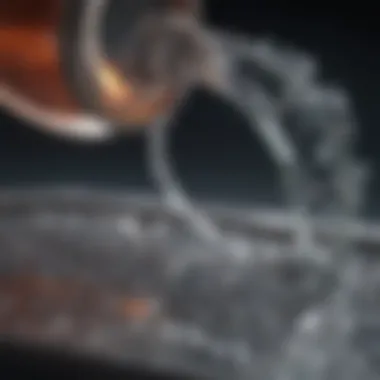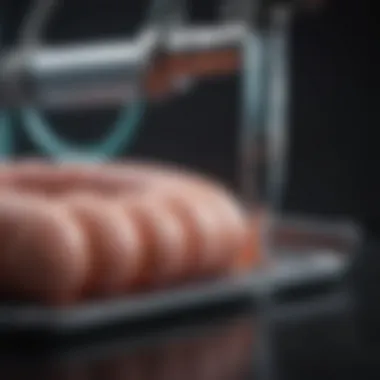Comparative Analysis of TPN and Tube Feeding


Intro
Total Parenteral Nutrition (TPN) and tube feeding represent two distinct methods of delivering essential nutrients to patients, particularly those with compromised digestive systems. Understanding the differences between these approaches is crucial for healthcare professionals. This article aims to clarify the mechanisms, indications, benefits, and potential complications associated with both TPN and tube feeding. Such knowledge not only enhances patient care but also informs decision-making processes in clinical settings.
While both methods serve the overarching purpose of nutritional support, they differ significantly in execution and patient implications. TPN entails administering nutrients intravenously, which bypasses the gastrointestinal tract entirely. Tube feeding, in contrast, employs various forms of enteral feeding techniques, directly supplying nutrients to the stomach or intestine. The selection between these two methods hinges on individual patient needs, existing medical conditions, and specific therapeutic objectives.
This analysis will cover key concepts that delineate when to choose TPN over tube feeding, or vice versa. With each feeding strategy having its unique advantages and risks, this guide intends to illuminate choices faced by healthcare practitioners, ultimately fostering improved patient outcomes.
Prelims to Nutritional Support
Nutritional support is a vital aspect of patient care, particularly for those who are unable to meet their nutritional needs through oral intake. Its importance cannot be overstated, as proper nutrition plays a crucial role in recovery from illness, surgery, or injury. By understanding the principles behind nutritional support, healthcare providers can tailor their approach to meet the individual requirements of patients. This article aims to present both Total Parenteral Nutrition (TPN) and tube feeding, highlighting differences and indications for each method.
Understanding Nutritional Requirements
To provide adequate nutritional support, it is crucial to comprehend the individual nutritional requirements of patients. These requirements are unique and can depend on various factors including age, sex, weight, and health status. Nutrition encompasses macronutrients such as carbohydrates, proteins, and fats, as well as micronutrients like vitamins and minerals. Every patient has varying needs based on their physiological state. For instance, a post-operative patient may require higher protein intake to facilitate tissue repair, while chronic disease patients may need tailored diets to manage their conditions.
Healthcare providers should assess factors such as basal metabolic rate, level of activity, and specific dietary restrictions before initiating any nutritional support. Tools such as nutritional screening protocols and assessment scales can assist in evaluating these individual needs effectively.
The Role of Nutritional Support in Healthcare
Nutritional support serves a multifaceted role in healthcare. Its primary function is to prevent or correct malnutrition. Malnutrition can lead to serious complications, prolong recovery, and increase hospital stays. Providing balanced nutritional support can enhance immune function, improve wound healing, and promote overall physiological recovery.
The importance of nutrition in medical treatment is increasingly recognized, with studies showing that adequate nutrition can lead to better clinical outcomes.
In clinical settings, nutritional support is also used as a therapeutic measure. Different types can be applied based on the patient's specific needs, whether those needs stem from surgical recovery, chronic illness, or acute conditions. Nutritional support, whether through TPN or tube feeding, plays an essential role in hospital protocols, enhancing quality of care and patient outcomes.
Understanding the intricate dynamics of nutritional needs and the role of nutritional support provides a solid foundation for exploring the comparative aspects of TPN and tube feeding in later sections.
Total Parenteral Nutrition (TPN)
Total Parenteral Nutrition is a crucial topic in the context of providing nutrition to patients who cannot eat orally or have severe digestive issues. TPN delivers a complete nutritional solution directly into the bloodstream. This method allows for individualized nutrient delivery based on patient-specific requirements. In many cases, TPN is the only viable option for maintaining nutritional status.
Definition and Mechanism of Action


TPN involves the intravenous administration of a sterile solution containing essential carbohydrates, proteins, fats, vitamins, and minerals. These solutions bypass the digestive system, directly supplying nutrients to the bloodstream. TPN can be administered through a central venous catheter, which ensures that the nutrients are efficiently absorbed. This method is particularly useful for patients with conditions such as severe gastrointestinal dysfunction, bowel obstruction, or postoperative recovery when traditional feeding is not feasible.
Indications for TPN Use
The use of TPN is indicated in various clinical situations, such as:
- Patients unable to consume sufficient nutrients orally or via tube feeding due to medical conditions.
- Conditions like inflammatory bowel disease, short bowel syndrome, and severe pancreatitis.
- Preoperative and postoperative patients at risk for malnutrition.
The decision to use TPN must be carefully considered, taking into account the patient’s overall health and nutritional needs.
Components of TPN Solutions
TPN solutions typically consist of:
- Carbohydrates: Primarily in the form of dextrose, which provides a quick source of energy.
- Proteins: Delivered as amino acids to support tissue repair and immune function.
- Lipids: Fats are included to provide essential fatty acids and additional calories.
- Vitamins and minerals: These are crucial for metabolic functions and overall health.
The precise composition depends on the individual requirements of the patient, which can vary based on underlying medical conditions.
Benefits of TPN
TPN offers several benefits, including:
- Nutritional support for patients who cannot eat or absorb nutrients effectively.
- Enables provision of individualized nutrition, tailored to specific deficiencies or medical needs.
- Helps prevent malnutrition and supports recovery in critically ill patients.
- Allows for gradual introduction of feeding methods as the patient’s condition improves.
This targeted support can significantly impact recovery times and improve quality of life.
Potential Complications of TPN
While TPN is beneficial, it is important to recognize its potential complications. These can be categorized as follows:
Metabolic Complications
Metabolic complications can arise from the use of TPN, including imbalances in electrolytes, hyperglycemia, and liver dysfunction. These issues can lead to significant health challenges. Monitoring metabolic parameters closely is critical during TPN therapy to mitigate risks and adjust nutrient delivery according to individual needs.
Mechanical Complications


Mechanical complications often pertain to the catheter used for TPN. These can include catheter misplacement, occlusion, or thrombosis. Such complications necessitate appropriate management to ensure continued access for nutrition without causing trauma to the patient or requiring additional invasive procedures.
Line Infections
Line infections are a serious risk associated with TPN. Bacteria can enter through the catheter line, leading to sepsis or localized infections. Prophylactic measures, such as strict adherence to sterile techniques and regular monitoring, are essential to minimize this risk. Understanding the implications of line infections is crucial for maintaining patient safety and effective nutritional support.
"Total Parenteral Nutrition requires careful management to optimize patient outcomes while minimizing risks."
Tube Feeding
Tube feeding is a significant method for delivering nutrition in patients who are unable to consume food orally. Understanding this process is crucial in medical settings, where patients often present challenges that prevent normal dietary intake. Tube feeding offers a solution by providing the necessary nutrients directly into the gastrointestinal system.
Definition and Mechanism of Action
Tube feeding involves the direct delivery of nutritional liquid through a tube that is inserted into the stomach or intestines. This method bypasses the need for oral intake, ensuring that patients receive the required nutrients irrespective of their ability to swallow or absorb food. The primary function is to facilitate nutritional supply while minimizing complications that arise from inadequate intake.
Types of Tube Feeding
- Nasogastric Feeding
Nasogastric feeding utilizes a tube that enters through the nose and extends to the stomach. This method is non-invasive and can be instituted quickly, which is particularly valuable in emergency settings. Its primary advantage is the ease of insertion without necessitating surgical intervention. However, the trade-off is that it can be uncomfortable for long-term use, making it less ideal for patients needing prolonged feeding support. - PEG Tube Feeding
Percutaneous Endoscopic Gastrostomy (PEG) tube feeding involves inserting a tube directly into the stomach through the abdominal wall. This approach is favored for patients requiring long-term nutrition therapy, as it reduces the discomfort associated with nasal tubes. The key characteristic of PEG feeding is its permanence, allowing patients to receive nutrition for months or even years, yet it involves surgical placement, which carries inherent risks. - Jejunostomy Feeding
Jejunostomy feeding involves placing a tube directly into the jejunum, part of the small intestine. This technique is critical for patients with severe gastric issues or those at high risk for aspiration. The key advantage of this method is it bypasses the stomach, directly providing nourishment into the intestines. However, placement of a jejunostomy tube is more invasive than other types and may lead to complications, including infection or obstruction.
Indications for Tube Feeding Use
Indications for tube feeding include situations where patients are unable to meet their nutritional requirements orally. This includes conditions like neurological impairments, certain cancers, or severe trauma. When patients demonstrate inability to swallow or have a risk for aspiration, tube feeding becomes a vital intervention to prevent malnutrition and support recovery.
Benefits of Tube Feeding
The benefits of tube feeding are numerous. Firstly, it ensures a consistent supply of essential nutrients tailored to individual needs. It also allows for monitoring of caloric intake and overall nutritional status. Additionally, tube feeding can support the recovery process, promote healing, and improve the quality of life for individuals who are medically compromised.
Possible Complications of Tube Feeding
Complications can occur with tube feeding, and understanding these is crucial for patient safety.
- Tube Displacement
Tube displacement refers to the misplacement of the feeding tube, which can lead to inadequate nutrition or aspiration. This issue highlights the need for regular checks to ensure proper tube position. Patients and caregivers should be educated on how to identify signs of displacement and the protocols for dealing with it. - Aspiration Pneumonia
Aspiration pneumonia is a serious condition resulting from inhaling food or liquid into the lungs. This is a primary concern for patients with tube feeding, especially those with swallowing difficulties. Monitoring and proper techniques in feeding administration can help mitigate this risk, but it remains a potential complication. - Digestive Complications
Digestive complications may include diarrhea, constipation, and gastric reflux. These issues can arise due to the composition of the feeding formula, the rate of administration, and individual patient responses. Constant assessment and adjustments to feeding plans are necessary to prevent and address these complications.
Tube feeding serves as a critical alternative for patients with inadequate oral intake, ensuring that nutritional needs are met while minimizing complications.
In this section, we explore the comparative analysis of Total Parenteral Nutrition (TPN) and tube feeding. Both methods serve to provide essential nutrition to patients, yet they do so in fundamentally different manners. The importance of distinguishing between these two approaches lies in their unique clinical indications, nutritional adequacy, cost implications, and the overall patient experience. By understanding the nuances of each method, healthcare professionals can tailor nutritional support to match patient needs better, ultimately improving health outcomes.
Clinical Indications for Each Approach
The choice between TPN and tube feeding is often dictated by specific clinical indications. TPN is frequently indicated for patients who have severe gastrointestinal dysfunction. This includes conditions such as bowel obstruction, inflammatory bowel disease, or post-operative recovery where the gut is not functional. In these cases, TPN serves as a lifeline, providing all necessary nutrients intravenously.


On the other hand, tube feeding is suitable when a patient's gastrointestinal system is functional but they cannot orally ingest sufficient nutrition. This may apply to individuals with swallowing difficulties or neurological impairments such as stroke or ALS. Thus, recognizing the specific clinical circumstances is vital in determining which nutrition delivery method is appropriate.
Nutritional Adequacy
Nutritional adequacy is a critical aspect when comparing TPN and tube feeding. TPN can be customized to meet the precise nutritional needs of the patient through careful formulation of macronutrients and micronutrients in the solution. This customization ensures that the patient receives optimal nutrition, which is crucial in critical care situations.
Conversely, tube feeding provides a pre-mixed formula designed to meet standard nutritional requirements. While these formulas can often be adjusted, they may not offer the same level of precision as a tailored TPN. However, the use of tube feeding can allow for some oral intake, which may be beneficial for patient morale and psychological well-being.
Cost Considerations
Cost is a significant factor in determining the appropriate nutritional support method. TPN is typically more expensive due to the need for specialized formulations and monitoring. The costs can accumulate from the ingredients, equipment, and the need for skilled healthcare professionals to manage the infusions. Additionally, TPN requires careful monitoring for potential complications, which also incurs further expenses.
In contrast, tube feeding is usually less expensive. The formulas can be less costly and are often easier to administer. Furthermore, the required monitoring tends to be less intensive, which can lead to overall savings. Recognizing these cost factors is essential in budget-conscious healthcare environments.
Patient Tolerance and Acceptance
Lastly, patient tolerance and acceptance of the nutritional method must be considered. TPN may have a challenging acceptance for patients because it is administered intravenously and comes with potential complications. These can include infections or metabolic imbalances. Patients often prefer methods that align more closely with normal eating patterns.
In contrast, tube feeding can be more acceptable to patients who may still experience some connection with oral ingestion. While certain patients may experience discomfort or dislodgment of the tube, the psychological benefits of having a method that resembles eating cannot be overlooked. Careful consideration of patients’ preferences and their emotional needs can significantly impact their recovery process.
"Understanding the differences between TPN and tube feeding can help healthcare professionals select the optimal method based on clinical evidence and patient needs."
Ending
Concluding any deep exploration of Total Parenteral Nutrition (TPN) and tube feeding demands an understanding of their operational nuances and the relative advantages each presents in clinical contexts. Each method serves distinct patient needs, presenting critical implications for patient care. The conclusion synthesizes these similarities and differences in a way that bolsters decision-making for healthcare professionals.
Summary of Key Findings
A structured synthesis of the key points from this analysis reveals two fundamentally distinct approaches to nutritional support. TPN is predominantly utilized when the gastrointestinal (GI) tract is non-functional or needs complete rest. It offers comprehensive nutrient delivery through the intravenous route, which is essential for patients unable to digest food normally.
On the other hand, tube feeding allows for nutritional support via the GI tract, suitable for patients with functioning gastrointestinal systems but who are unable to consume food orally. Key operational differences include:
- Nutritional Delivery: TPN provides all necessary nutrients directly into the bloodstream, while tube feeding administers nutrition through an enteral route.
- Complications: Metabolic and mechanical complications are significant in TPN, whereas tube feeding has risks such as tube displacement and aspiration pneumonia.
- Patient Tolerance: Generally, tube feeding may offer a more familiar experience of eating, aligning with psychological aspects of food consumption.
Understanding these differences allows healthcare providers to tailor their approach based on individual patient conditions, potentially improving health outcomes and quality of life.
Guidelines for Choosing Between TPN and Tube Feeding
Selecting the appropriate form of nutritional intervention hinges on various patient-specific factors. Here are critical considerations that should guide this decision:
- Patient Assessment: Evaluate the patient's gastrointestinal function. If the GI tract is intact and functional, tube feeding is often preferred.
- Clinical Condition: Certain conditions, such as severe pancreatitis or bowel obstructions, may warrant TPN.
- Nutritional Goals: Consider the nutritional needs of the patient. If rapid nutrient delivery is essential, TPN benefits may outweigh its complications.
- Duration of Feeding: For long-term support, tube feeding may entail fewer risks and complications.
- Patient Preference: Engage the patient in discussions regarding their preferences and comfort with each method.
- Cost Effectiveness: Assess costs associated with both methods, as tube feeding often incurs less expense than TPN due to simpler administration protocols.







